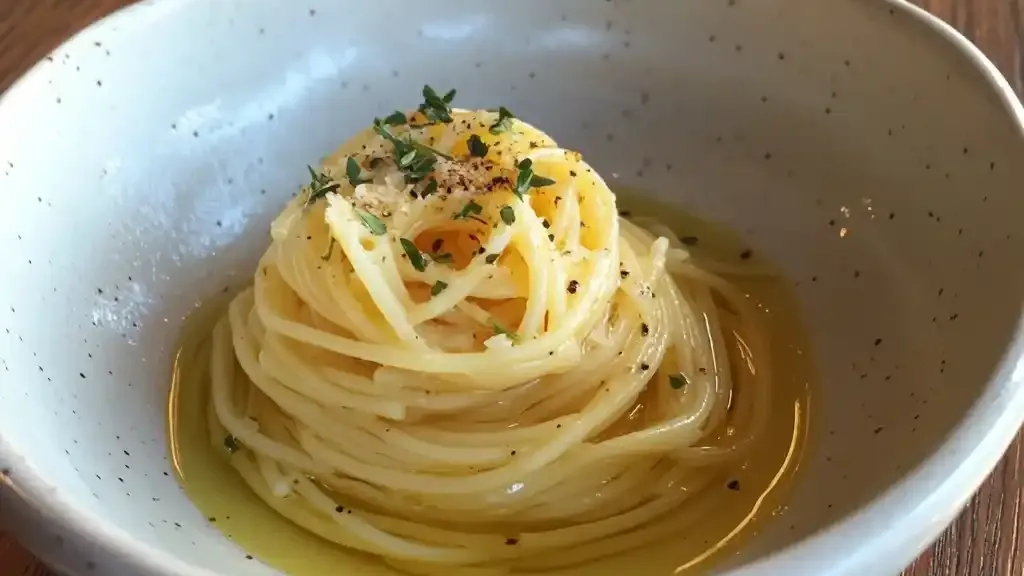Spaghettini pasta, hailing from Southern Italy, is a culinary treat known for its thin, delicate strands that enhance a wide range of dishes. Often referred to as “thin spaghetti,” this versatile pasta is lighter and quicker to cook than its traditional counterpart, making it ideal for quick, elegant meals. In this guide, we’ll explore everything about spaghettini, from its history and preparation to its place in global cuisine.
Table of contents
- What is Spaghettini Pasta?
- Historical Background
- Types and Variants of Spaghettini Pasta
- How to Cook Spaghettini Pasta Perfectly
- Health Benefits of Spaghettini Pasta
- Spaghettini Pasta in Global Cuisine
- Buying and Storing Spaghettini Pasta
- FAQs About Spaghettini Pasta
- Spaghettini Pasta: A Delicious Guide
- Conclusion
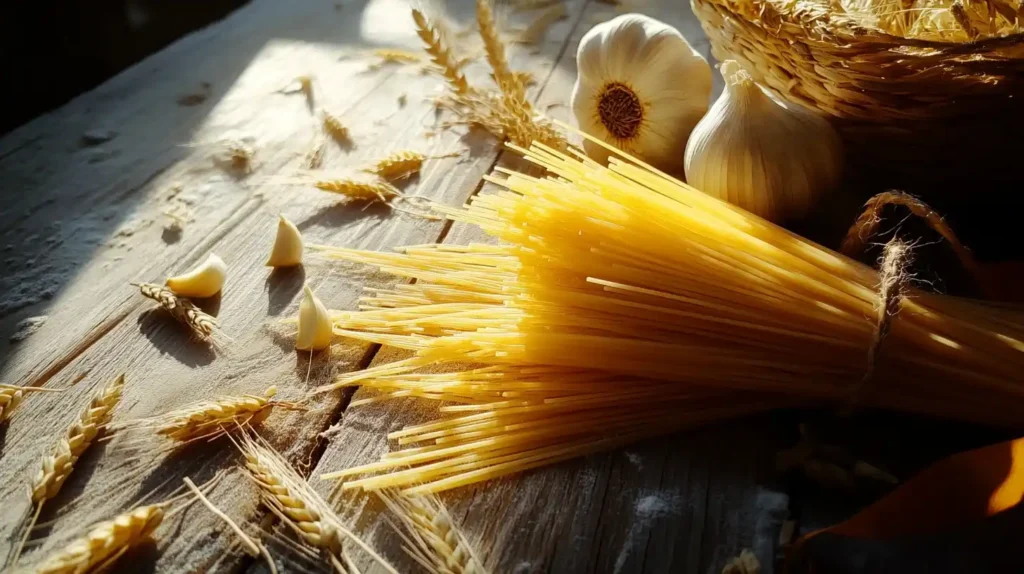
What is Spaghettini Pasta?
Spaghettini pasta comes from Southern Italy and offers a lighter, thinner version of regular spaghetti. Its delicate strands cook faster, making it a great choice for busy days. You can easily pair it with simple sauces like olive oil or garlic for a quick, flavorful meal.
Italian chefs make spaghettini from durum wheat, which gives it a firm texture after cooking. Many producers use bronze dies to shape the pasta, which creates a rough surface. This rough texture allows sauces to stick well, so each bite tastes delicious.
Over time, cooks and families around the world have embraced spaghettini for its versatility. It works wonderfully in many dishes, from light salads to hearty seafood recipes. To learn more about the craft behind Italian pasta, you can visit this Authentic Italian Pasta Guide.
Historical Background
Spaghettini pasta has a rich history that traces back to the southern regions of Italy. It grew popular because its thin strands made it easy to cook quickly, which suited the fast-paced lifestyles of the time. Families often paired it with fresh, local ingredients like olive oil, garlic, and herbs, creating simple yet flavorful meals.
Over the centuries, Italian cooks perfected their methods for making spaghettini. They used traditional techniques, like bronze-die extrusion, to ensure the pasta had the right texture. This method created spaghettini’s signature rough surface, allowing sauces to cling better. As a result, it became a staple in many households.
As Italian immigrants moved to other countries, they brought spaghettini with them. It soon became a favorite in international kitchens, celebrated for its versatility and lightness. Today, you can find spaghettini on menus worldwide, from classic Italian recipes to fusion dishes that reflect global tastes.
By learning about spaghettini’s past, we can better appreciate its role in modern cuisine. Its story reminds us how simple ingredients, paired with skilled craftsmanship, can create something truly timeless.
Types and Variants of Spaghettini Pasta
Spaghettini pasta comes in several varieties, each offering unique qualities that make it suitable for different dishes. Understanding these types can help you choose the perfect one for your next meal.
Authentic Italian Spaghettini
Traditional Italian spaghettini is made with durum wheat semolina, a high-quality ingredient that gives it firmness and flavor. Many Italian producers follow age-old methods, such as bronze-die extrusion, to create pasta with a rough texture. This texture is ideal for light sauces, as it holds onto flavors exceptionally well.
Global Variations
Although spaghettini originates from Italy, its popularity has inspired adaptations in other cuisines. For instance:
- Asian Fusion: Spaghettini is often used in stir-fried dishes with soy-based sauces and vegetables.
- Mexican Twists: It appears in spicy soups and salads, blending traditional Mexican flavors with Italian techniques.
How It Differs From Other Pastas
It’s easy to confuse spaghettini with other types of thin pasta, but they have distinct differences:
- Spaghettini vs. Spaghetti: Spaghettini is thinner, making it cook faster and feel lighter.
- Spaghettini vs. Angel Hair: Angel hair is even thinner than spaghettini, which can make it more delicate and less versatile in heavier dishes.
By understanding these differences, you can better select the right pasta for your recipe. No matter which variety you choose, spaghettini adds a light and elegant touch to any meal.
How to Cook Spaghettini Pasta Perfectly
Cooking spaghettini pasta to perfection might seem simple, but a few tips can make all the difference. By following these steps, you’ll ensure your dish turns out light, flavorful, and satisfying.
Choose High-Quality Pasta
Start by selecting high-quality spaghettini. Look for brands that use durum wheat and traditional methods like bronze-die extrusion. These features ensure the pasta has the right texture for holding sauces.
Step-by-Step Cooking Guide
- Boil Water: Use a large pot and bring plenty of water to a rolling boil. Add a generous pinch of salt for flavor.
- Add the Pasta: Once the water is boiling, add your spaghettini. Stir gently to keep the strands from sticking together.
- Cook Al Dente: Spaghettini cooks quickly, usually in 6–8 minutes. Test it by biting a strand—it should be tender but slightly firm.
- Drain and Save Some Water: Drain the pasta but save a cup of the cooking water. The starchy water can help blend sauces more smoothly.
Pairing Spaghettini Pasta with Sauces
Choosing the right sauce can elevate your dish:
- Light Sauces: Olive oil, garlic, and fresh herbs pair beautifully with the delicate strands.
- Seafood Combinations: Spaghettini works wonderfully with shrimp, scallops, or clams.
- Vegetarian Options: Toss it with roasted vegetables, cherry tomatoes, or pesto for a simple yet vibrant meal.
If you prefer richer flavors, you might enjoy Fettuccine Sauce, known for its creamy, indulgent texture. While fettuccine is best suited for thick, hearty sauces, spaghettini’s delicate structure pairs better with lighter or seafood-based options. Choosing the right sauce ensures that each bite is balanced and delicious.
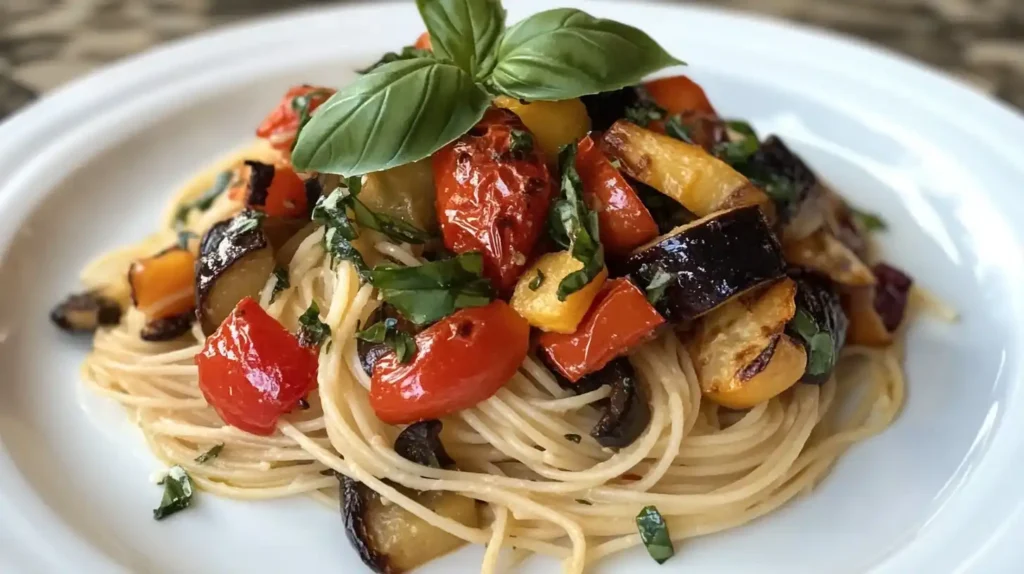
Common Mistakes to Avoid
- Overcooking: This can make the pasta mushy. Always keep an eye on the timer.
- Skipping Salt: Salting the water enhances the pasta’s flavor.
- Rinsing the Pasta: Never rinse spaghettini after draining, as this washes away the starch that helps sauces stick.
By following these tips, you’ll achieve perfectly cooked spaghettini every time. The key is to focus on quality ingredients and keep the process simple.
Health Benefits of Spaghettini Pasta
Spaghettini pasta is not only delicious but also offers several health benefits when enjoyed as part of a balanced diet. With the right ingredients and portions, it can fit into various dietary preferences and lifestyles.
Rich in Complex Carbohydrates
Spaghettini provides a good source of complex carbohydrates, which supply long-lasting energy. Unlike simple carbs, these are digested slowly, helping to maintain steady blood sugar levels and keep you feeling full for longer.
Low in Fat
When prepared without heavy sauces or fried toppings, spaghettini is naturally low in fat. Pairing it with fresh vegetables, lean proteins, or olive oil keeps your meal light and nutritious.
Dietary Adaptability
Spaghettini caters to many dietary needs:
- Gluten-Free Options: For those with gluten intolerance, gluten-free spaghettini made from alternative grains like rice or quinoa is widely available.
- Kosher-Certified Pasta: Many brands ensure their spaghettini meets kosher standards, making it suitable for diverse lifestyles.
- Vegan-Friendly: Most traditional spaghettini recipes contain only wheat and water, making them suitable for plant-based diets.
A Balanced Approach
While spaghettini is healthy, portion control is essential. A typical serving size (about 2 ounces or 56 grams) provides energy without overloading on calories. Adding nutrient-rich toppings like steamed vegetables, lean meats, or a handful of nuts enhances the dish’s nutritional value.
Why Moderation Matters
It’s important to enjoy spaghettini in moderation, especially if served with rich, creamy sauces. Balancing your pasta with fresh ingredients ensures you get a variety of nutrients without unnecessary calories.
With its versatility and health benefits, spaghettini pasta can be a great choice for those seeking delicious and nourishing meals.
Spaghettini Pasta in Global Cuisine
Spaghettini pasta is loved worldwide for its versatility and light texture. While it remains a cornerstone of Italian cooking, it has found its way into many international dishes. Let’s explore how this thin pasta adapts to different cuisines.
Italian Classics
In Italy, spaghettini is celebrated for its simplicity and elegance. Here are some popular Italian recipes:
- Spaghettini Aglio e Olio: A quick dish featuring olive oil, garlic, and red pepper flakes, ideal for busy evenings.
- Seafood Spaghettini: Often paired with clams, mussels, or shrimp, spaghettini shines in coastal Italian dishes.
- Tomato-Based Sauces: Lighter than spaghetti, spaghettini pairs well with fresh tomato sauces infused with basil and oregano.
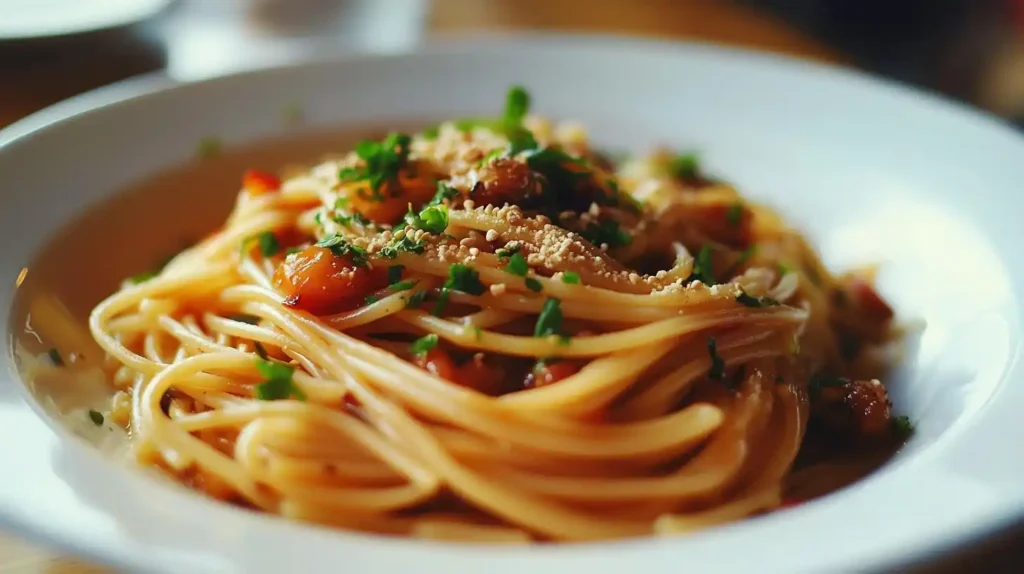
Asian Fusion Creations
In Asian cuisine, chefs often use spaghettini as a substitute for noodles in stir-fries and soups:
- Soy Sauce Stir-Fry: Spaghettini combines beautifully with soy sauce, sesame oil, and vegetables for a savory twist.
- Spicy Soups: In broths flavored with chili and ginger, spaghettini offers a hearty base.
Mexican Twists
Spaghettini fits seamlessly into Mexican-inspired dishes:
- Fideo-Style Pasta: Similar to vermicelli, spaghettini is used in brothy soups spiced with cumin and chili.
- Cold Pasta Salads: Tossed with beans, corn, and a zesty lime dressing, spaghettini adds a refreshing touch to summer meals.
Fusion Dishes
As global cuisines continue to blend, spaghettini is a go-to ingredient for chefs creating fusion dishes. Its light texture makes it a great canvas for experimenting with bold flavors, from Thai-inspired peanut sauces to Middle Eastern tahini-based dressings.
By embracing its versatility, you can use spaghettini to bring an international flair to your kitchen. From Italy’s heartwarming classics to adventurous fusion recipes, this pasta proves its global appeal.
Buying and Storing Spaghettini Pasta
Choosing the right spaghettini pasta and storing it correctly are key to making delicious dishes. With a few simple tips, you can ensure your pasta stays fresh and flavorful.
How to Choose High-Quality Spaghettini
When shopping for spaghettini, look for these features to ensure you’re getting the best:
- Ingredients: High-quality spaghettini is made from 100% durum wheat semolina. This ensures a firm texture and great taste.
- Traditional Methods: Many premium brands use bronze-die extrusion. This technique creates a rough surface that helps sauces stick better.
- Certifications: Look for labels like “PGI Certified” or “Kosher-Certified” to confirm authenticity and dietary suitability.
Where to Buy
You can find spaghettini at local grocery stores, specialty Italian markets, or online retailers. Many online options also provide details about the pasta’s origin and crafting methods, which can help you make an informed choice.
Proper Storage Tips
To keep your spaghettini fresh and ready to use, follow these simple storage guidelines:
- Unopened Packages: Store in a cool, dry place, such as a pantry or cupboard. Avoid exposure to direct sunlight or humidity.
- Opened Packages: Seal tightly using a clip or transfer the pasta to an airtight container. This prevents moisture from affecting the quality.
- Shelf Life: Most dry spaghettini has a long shelf life of 1–2 years when stored properly.
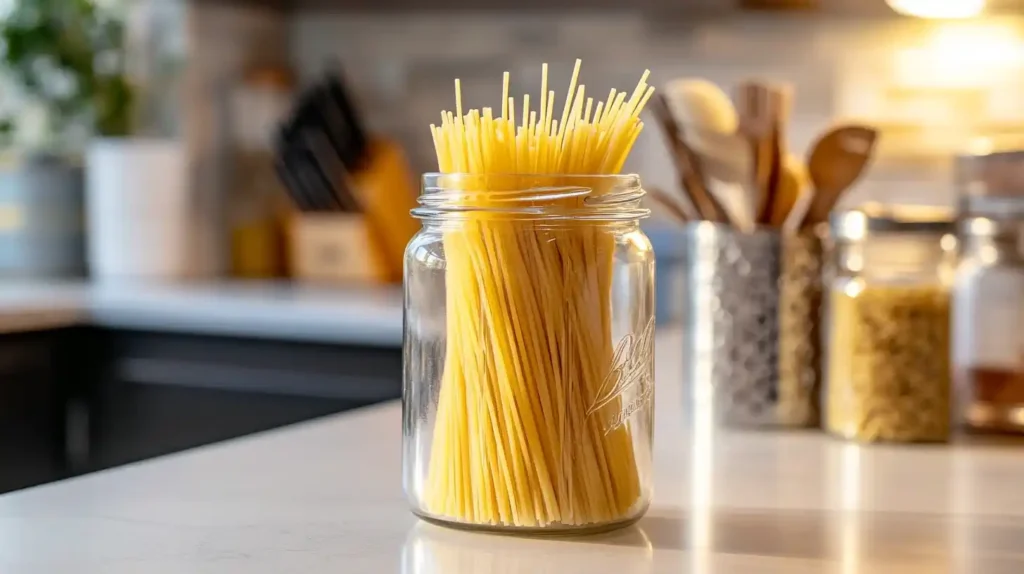
Why Storage Matters
Proper storage not only preserves the pasta’s flavor and texture but also prevents waste. By keeping your spaghettini in good condition, you’ll always have a quick and reliable ingredient on hand for meals.
With these tips, buying and storing spaghettini pasta becomes effortless, ensuring you’re always ready to create delicious dishes.
FAQs About Spaghettini Pasta
Curious about spaghettini pasta? Here are some of the most frequently asked questions, along with simple answers to help you enjoy this delicious pasta.
1. What is the best sauce for spaghettini?
Light sauces work best with spaghettini. For example, olive oil with garlic and fresh herbs creates a simple yet flavorful dish. Creamy or tomato-based sauces can also complement its thin texture without overwhelming it.
2. How is spaghettini different from angel hair pasta?
Although both are thin types of pasta, spaghettini is slightly thicker than angel hair. This makes it more versatile and better suited for a wider variety of dishes, including those with heartier sauces.
3. Can spaghettini be used in soups?
Yes, spaghettini is an excellent choice for soups. Its delicate strands cook quickly and add texture to brothy dishes like chicken soup or vegetable consommé.
4. What is the recommended cooking time?
On average, spaghettini takes 6–8 minutes to cook until it’s al dente. Be sure to check the package instructions for exact times, as these can vary by brand.
5. Is spaghettini healthier than regular pasta?
Spaghettini offers similar health benefits to other pasta types. However, its thin strands make portion control easier, which can help with calorie management. Pair it with vegetables and lean proteins for a nutritious meal.
6. What dishes can I make with spaghettini?
You can create a wide range of dishes, from classic Spaghettini Aglio e Olio to seafood pasta or even cold pasta salads. Its versatility makes it a great base for experimenting with new recipes.
By understanding these common questions, you can make the most of your spaghettini pasta. Whether you’re trying it for the first time or looking for fresh ideas, these tips will help you enjoy it to the fullest.
Spaghettini Pasta: A Delicious Guide
Spaghettini pasta is a versatile and delicate type of pasta originating from Southern Italy. Known for its thin strands, it’s a great choice for creating light and flavorful dishes. Whether paired with olive oil, garlic, or fresh vegetables, this pasta brings simplicity and elegance to any meal.
To make the most of spaghettini, it’s important to understand its history, cooking techniques, and how to pair it with the right ingredients.
What Makes Spaghettini Special?
Spaghettini stands out because of its delicate texture and quick cooking time. This pasta type is thinner than traditional spaghetti but thicker than angel hair, making it an excellent choice for light sauces like olive oil and garlic or seafood-based dishes.
How to Cook Spaghettini Pasta
- Boil Water: Use a large pot and plenty of water to avoid sticking. Add salt to enhance the pasta’s natural flavor.
- Cook Al Dente: Spaghettini cooks in just 6–8 minutes. Keep a close watch to avoid overcooking.
- Toss with Sauce: Pair spaghettini with simple sauces like olive oil and garlic or fresh tomato-based recipes for a classic touch.
Pairing Ideas for Spaghettini Pasta
Spaghettini’s light and delicate nature allows it to shine in various dishes:
- Seafood Pairings: Toss it with shrimp, clams, or scallops for a taste of the sea.
- Vegetarian Options: Add roasted vegetables and herbs for a nutritious, meat-free meal.
- Global Twists: Use spaghettini in fusion dishes inspired by Asian or Mediterranean flavors.
Conclusion
Spaghettini pasta is a kitchen staple that adapts to many recipes and cooking styles. Its thin, versatile strands make it an excellent choice for quick and flavorful meals. Pair it with light sauces or fresh ingredients to enjoy its delicate texture and subtle taste.

